Research in Bioengineering
An Investigation into the Effects of Inverted Growing on Development and Strength of Basil
By Megan Scribner
My OUR research project was entitled ‘An Investigation into the Effects of Inverted Growing on Development and Strength of Basil’. The objective of the research is to determine if growing basil upside down influences the plant’s development and the mechanical strength of the stems. The initial plan to grow basil plants from seeds was modified for the sake of time; instead, adult plants were purchased and used for experimentation.

Portrait of Megan Scribner
Fifteen mature basil plants were purchased, numbered, and transplanted into larger pots. Plants 1-7 were planted traditionally, upright (displayed in Figure 1a), and plants 8-15 were planted in pots fashioned so that the plant would hang upside down (displayed in Figure 1b). Stalks that had a second set of true leaves, and sufficient space between the pairs to make a cut, were pruned.
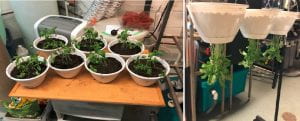
Figure 1a (left): The upright basil plants
Figure 1b (right): Some of the upside down basil plants on a garment rack
After four weeks of growth, it was observed that stems of upright plants that had been pruned on Day 1 had established pairs of offshoot stems with two or three sets of leaves. Stems of upside-down plants that had been pruned on Day 1 had established pairs of offshoot stems with only one or two sets of leaves. This suggests that the upright plants experienced increased growth compared to the upside-down plants. Figures 2 and 3 display this growth difference.
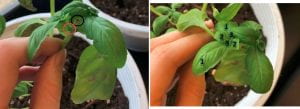 Figure 2: Pruned stem of plant 6 (upright) with 3 sets of new leaves. The black circle on the left highlights the location of the pruning cut. The red circle highlights where the new offshoot stems and leaves grew from the main stem. The sets of leaves are numbered on the right.
Figure 2: Pruned stem of plant 6 (upright) with 3 sets of new leaves. The black circle on the left highlights the location of the pruning cut. The red circle highlights where the new offshoot stems and leaves grew from the main stem. The sets of leaves are numbered on the right.

Figure 3: Two pruned stems from plant 11 (upside-down), each with 2 pairs of new leaves.
Several obstacles were encountered in trying to maintain healthy plants. Challenges included: growing basil during the late winter/early spring months (which is not basil’s typical growing season for this region), securing an indoor location that met the environmental needs of basil, and the presence of insects.
Due to the complications with maintaining consistently healthy plants, no formal measurements with the experimental plants have been taken at this time, but there have been several practice measurements including extracting chlorophyll and measuring the wavelengths with a spectrophotometer, staining stem cross sections with toluidine blue and observing the plant vasculature under a microscope, and experimenting with different grip set ups for tensile testing. Images of the practice stained samples have been included below in Figure 4.
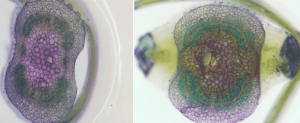
Figure 4: Two basil stem cross sections stained with toluidine blue and examined under a microscope
§
Chlorophyll wavelength measurements were taken using a spectrophotometer. I am currently reviewing published literature for additional information about the effect of a plant’s health on its chlorophyll production.
Apart from the plants being used for experimentation, an additional basil plant was purchased in order to conduct practice tensile tests and find the most effective grip set up for successful testing. Due to the available pieces of testing apparatus not having fixtures suitable for botanical samples, there were no successful practice tensile tests. In the majority of the practice tests, the stem sample slipped through the grips. Examples of this are shown in Figures 5 and 6. In Figure 5, the stem slips from the start of testing. In Figure 6, the stem starts to deform as desired, but the sample begins to slip in the middle of testing. A successful tensile testing graph would look more like Figure 7. This graph was the result of one of the practice tests; however, the sample broke right at the bottom grip (displayed in Figure 8) which is not desirable. The sample should break more towards the center of the gage length. Breaking at the grips occurs due to improper stress concentrations through the sample; the grips are exerting too much force on the sample and weakening it at the grip points. Various materials such as sand paper and rubber were used to try to create more friction between the sample and the grips without applying too much force but these attempts were not successful.
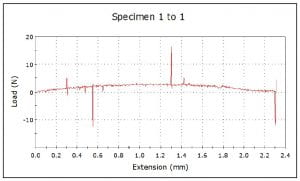
Figure 5: Load vs extension graph of a stem tensile testing sample that slips throughout testing
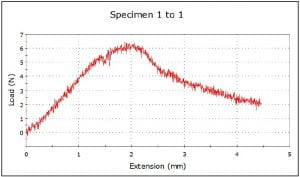
Figure 6: Load vs extension graph of a stem tensile testing sample that starts to deform and then begins to slip around 2mm
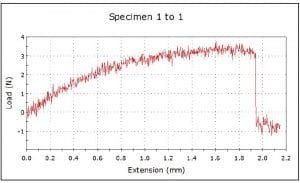
Figure 7: Load vs extension graph of a stem tensile testing sample. The sample deforms until breaks at about 1.9 mm
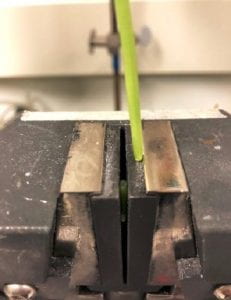
Figure 8: A stem tensile test sample that broke at the bottom grip
An alternative idea for tensile testing has been investigated but not yet tested. It involves wrapping the ends of the stem sample around hooks instead of compressing the ends in grips. This is a method commonly used for testing the tensile strength of string samples. This set up does not have all the necessary components, but the available components have been gathered as seen in Figure 9. There may be some need for manufacturing in order to complete the testing set up. This will be explored further during the fall 2018 semester.
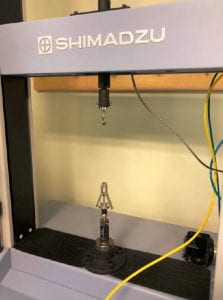
Figure 9: Top hook for future tensile tests. A bottom hook needs to be properly fashioned for this testing set up
§
The current plans for the continuation of this project consist of obtaining and maintaining a new set of plants over the summer months in order to establish a healthier set of samples. Measurements from this healthier set of plants will be collected in the fall 2018 semester.
The research grant provided to me by the Office of Undergraduate Research allowed me to obtain many necessary materials including the plants and the various materials needed to care for them. While no conclusive measurements have been collected, these funds and materials provided me the opportunity to conduct valuable troubleshooting for this project. I would not have been able to pursue researching this unique application of mechanical engineering without the support of the grant. I would like to acknowledge my advisor Dr. Tracie Ferreira for her support and guidance with this project.

